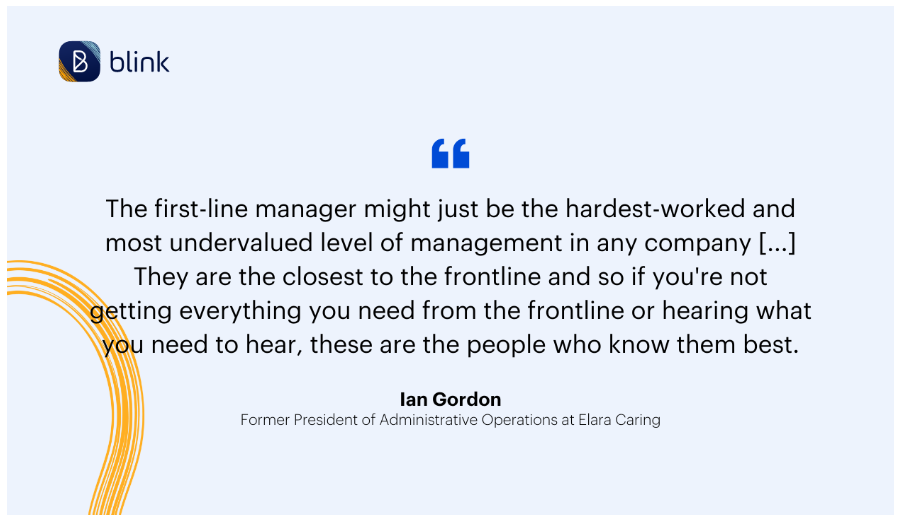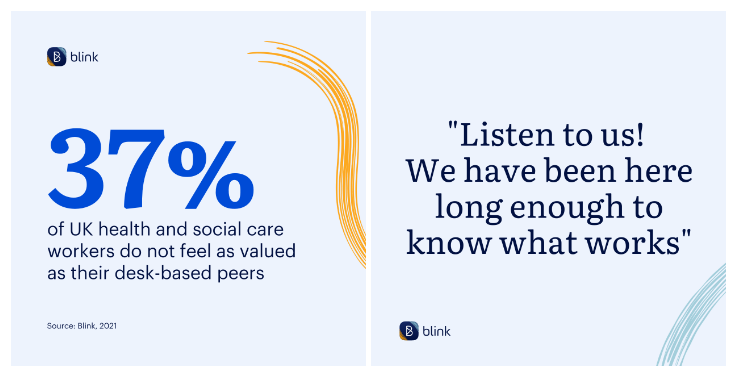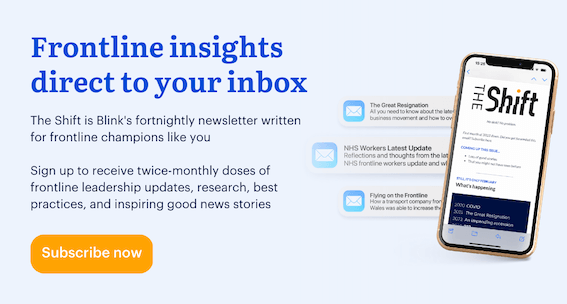Managing frontline employees is an altogether different task than leading a desk-based team.
For one, you’re usually working in shift patterns and you might have insufficient tooling to keep you all connected. This connection gap makes it all the harder to navigate the “Great attrition” risks and widespread disengagement that most first-line/frontline managers are faced with.
But we don’t need to linger on the reasons why managing the frontline can be hard. Let’s focus instead on how to do it more effectively.
Because if we can empower first-line managers to better manage their teams, we can help reduce attrition, increase engagement, and improve the employee experience for everyone.
In this guide, we'll discuss your role as a frontline manager, the challenges faced by frontline teams and their managers, and the best practice approaches you can adopt when managing frontline employees.
Understanding the first-line manager role
Frontline managers play a pivotal role in any deskless organization and account for roughly 60% of a company’s management ranks. They are responsible for managing the day-to-day activities of their teams and ensuring that their organization's frontline remains strong and efficient.
Ultimately, the role of a first-line leader is to enable frontline workers to do their jobs effectively. This might include setting objectives, delegating tasks, providing feedback on frontline employee performance, and ultimately driving organizational success. But it also means giving positive and constructive feedback: celebrating a job well done and stepping in to rectify when things aren’t going right.
And yet, first-line managers are often “accidental managers”, too. They might have been promoted to a managerial role because of their subject matter expertise and hands-on experience in the business — but they’ve yet to receive any dedicated management or employee engagement training to prepare them for the job. A large proportion (around 40% based on recent Harvard Business Review research) are first-time managers as well, in the very first year of their leadership journey.
Maybe that’s a description that resonates? And if it is, you’ll also be able to appreciate how that makes the role more difficult.

First-line managers: overworked and under-invested in?
First-line managers can be the hardest working and most undervalued level of management — under pressure from all angles and expected to pick up the slack caused by frontline labor shortages.
When an organization propels someone into a leadership role with insufficient training and insufficient support, we can hardly be surprised if they struggle to perform. And many first-line managers do: 60% in fact, over their first two years.
Flipping that figure around and helping first-line managers to perform is relatively easy to achieve.
A frontline manager’s potential can be unlocked by:
- Providing them with tools for proper team-wide communication and workforce management
- Investing in management training (particularly around HR-related topics, such as redundancies and employee relations)
- Investing in employee engagement training to help manage and improve team morale
- Alleviating the strain of manual, repetitive tasks to free up their time to better manage their teams
Doing so is in everyone’s best interests. Frontline employees will receive a better and more fulfilling workplace experience which helps them deliver a better quality of service to customers. The impact of this will be felt on the organization’s bottom line, making frontline manager empowerment a business-critical mission for the C-Suite and other leaders.
If you’re a first-line manager, it’s good to know your worth.
You are in a unique position within the organization — you’re frontline-facing and can act as a touchpoint between frontline workers and your desk-based peers. You can also be the catalyst for better frontline employee engagement and motivation.

Common challenges when managing frontline employees
If you’re facing challenges as a first-line manager, know that you’re not alone.
There are a number of common issues impacting frontline teams, including:
- Poor communication and engagement
- Attrition and turnover
- Labor shortages
- Unstable service levels and disappointed customers
- Lack of useful tooling
- Lack of training for frontline teams
- Lack of training for first-line managers themselves
Attrition, turnover, and the unavoidable staff shortages that follow can seriously impact the quality of service provided by the frontline workforce. Frontline teams increasingly struggle to cover more tasks with fewer resources — and it’s often the first-line manager who is left racing to fill empty shifts, deliver on tasks, or explain the drop in productivity to other senior management.
High turnover rates can also have a detrimental effect on frontline team morale, as new employees come in and existing ones leave at a rapid rate. Open communication between you and your team — which also means providing fit-for-purpose employee engagement tools and solutions, and employee engagement activities — will be key in helping to build trust and loyalty within the organization.
Finally, frontline managers must effectively advocate for their teams when they are not getting adequate support from executives and training from the business. This may involve having difficult conversations with the C-Suite or presenting frontline engagement data that shows the value of investing in frontline teams.
7 best practices when managing frontline employees
1. Thorough onboarding
It’s important to provide all new team members with a detailed onboarding program. You want to create a sense of community for them and ensure that they know any responsibilities and KPI expectations for the role from the get-go.
All frontline employees should receive adequate training for their specific roles and ensure they understand the requirements of their job. This will be a compliance must-do in many frontline organizations, of course, but even if the role is light on health and safety or legal regulations, you’ll want to take the time to outline the responsibilities clearly.
Onboarding can be a time-consuming process but it's an early driver of employee engagement, so explore the tools you have available to help lighten the load.
Again, the business case for doing so is easy to sell to decision-makers: the faster you can onboard new joiners, the sooner they can help move the business forward (and the less time and focus you’ll lose on your other essential tasks).
2. Active listening
Listening — and we mean really listening — to your frontline teams is essential for successful frontline management.
It can be difficult for frontline employees to feel heard, as they are often more spread out than desk-based colleagues and have less access to resources and support. As a frontline manager, it is important to ask for, actively listen to, and then share the concerns of your team.

3. Communicate across the board
Frontline teams have a unique brief when it comes to internal communications, and there aren’t too many tools that are really fit for purpose.
Having access to a mobile-first frontline employee app can help keep everyone in the organization connected. As a first-line manager, you can lead by example — posting and commenting on company updates, messaging frontline employees directly and within groups, as well as making sure that senior leaders are seeing what’s being shared.
By prioritizing communication with your frontline employees, you can ensure they always feel informed, appreciated, and engaged — no matter how infrequently you see them face to face.
4. Support and pastoral care
Management support is key for each team member to feel valued and to keep morale high knowing that their supervisor has their back. This can be done through regular check-ins, providing tailored resources for their development, and actively listening to — and actioning — their feedback for the business.
Empowering your frontline workforce with the support of intuitive scheduling solutions and the autonomy to manage their own workloads can also help them feel valued and give them a sense of responsibility.
Finally, providing instant access to mental health resources will enable employees to feel safer in the work environment, and more comfortable in approaching their manager with any issues they may have.
A TikTok video showing a restaurant manager comforting a tearful employee sparked a big conversation about pastoral care for frontline teams. You will find an approach that feels comfortable and beneficial for you and the people you work with every day.
5. Professional development
Many frontline workers feel that they do not receive the same access to career advancement opportunities as their desk-based colleagues. This can leave frontline staff feeling undervalued and, unsurprisingly, employee motivation starts to dwindle.
Professional development is key for frontline employees. Frontline managers know what is expected of them, and what it takes to be successful in the role. If you see those characteristics in someone else, develop them. This might mean connecting them with development opportunities, recommending them for promotion or training, as well as checking that your frontline staff are happy with their career development via ongoing employee surveys.
By investing in your frontline team’s growth, you can ensure that their skills are kept up to date, increasing their confidence and improving their job satisfaction.
6. Reward hard work and commitment
It’s essential to provide frontline employees with tangible rewards for their hard work and dedication, just as you would your desk-based staff. Not seeing your deskless employees every day doesn’t equal forgetting about their contributions to your company — that’s something you may need to remind desk-based senior leaders.
Rewarding your frontline can be done in a variety of ways: bonus pay, gift cards, lunch vouchers, or even just a public shoutout across the company. This helps to show appreciation for their efforts and encourages them to continue striving for excellence. It also allows you to boost employee morale and create a positive working environment.
While rewarding great work is important, in the current economic climate, businesses don't always have the funds to pay frontline workers more. That's why reward and recognition should always go hand-in-hand.
7. Recognize team and individual achievements
Employee recognition, small or large, is crucial for motivating and inspiring team members.
Showing appreciation is a great way to boost morale and create a positive working environment. Recognizing employees can come in various forms such as verbal praise, recognition in meetings, and virtual employee recognition or Kudos.
If someone has dealt with a difficult customer or situation well, recognize this. If someone has worked extra hard to ensure quality of service, recognize this. Acknowledging great work can help empower employees and make them feel appreciated for their efforts. It’ll also make them more likely to perform that way again.
To retain a frontline worker and enable them to become a valuable asset to your organization, you need to ensure their efforts are recognized. By following this advice, you can show them that their hard work is appreciated and foster an environment of engagement and success.
Expert tips from frontline managers

Healthcare ops expert and former President of Administrative Operations at Elara Caring, Ian Gordon, has some key insights for us on the topic of engaging with frontline employees.
Here are just a few of his expert tips for navigating frontline management and engaging your deskless workforce:
- Create bi-directional communication: Communicating issues is a team effort. It starts with the CEO and runs the full way through to the frontline. Everybody has to own it
- Redeploy resources to the frontline: Increasing investments into the skills and capabilities of your frontline can be a true differentiator in the marketplace. It is also a good reason for your frontline to feel appreciated and invested in. Wondering where this extra budget will come from? If you can help retain employees with training and development, then you won’t need to spend so much on continuous recruitment
- The right tech: Being a frontline worker, you can’t spend a lot of time signing in and navigating complex tech. Having hub-based access to all-inclusive and easy-to-navigate information can really be a benefit to employees
Keeping frontline employees engaged is a key part of running a successful business.
Strategies for employee engagement and retention should cover the seven tips mentioned above. As well as providing accessible resources, frequent rewards and recognition, and implementing tailored technology solutions, you can foster an environment of engagement that will help to retain your frontline workers and enable them to become valuable assets for the organization.
Remember: investing in the growth of your frontline team is essential for success. With the right tools and support in place, you can create an environment of engagement in which everyone feels able to thrive.
Blink. And you’ve got a hotline to the frontline.
https://player.vimeo.com/video/723578311?h=c37bdbcb8b
Blink's industry-leading frontline app helps you take three simple steps to transform your frontline management.
- Enable: Give your frontline the tools, information, and inspiration they need to go above and beyond.
- Engage: Give your frontline instant access to the news, people, and information they need to feel part of the team.
- Understand: Use data and insights you need to make the best decisions for your frontline team.
With our one-stop solution, you can get rid of complex and outdated processes that are blocking your frontline's satisfaction — and their success. With Blink, you can finally empower your frontline with the tools they need to succeed.
Managing frontline employees FAQs
What makes a good frontline manager?
A good frontline manager is someone who understands the specific needs of their deskless team and puts them first. They should be able to communicate effectively, motivate, provide feedback, recognize great work, and create a culture of safety and respect in the workplace.
How can managers motivate frontline employees to perform at high levels?
Frontline employees need recognition and reward in order to feel motivated and perform at high levels. Managers should strive to create an environment of appreciation, where frontline workers know that their efforts are valued and appreciated, alongside providing the right tools and solutions that make their job easier.



